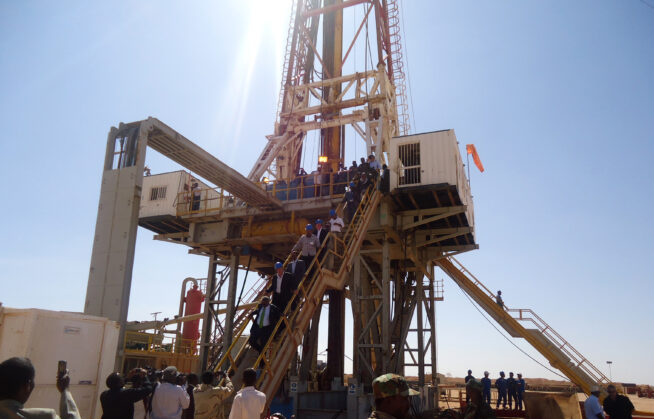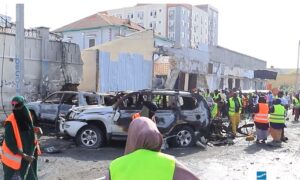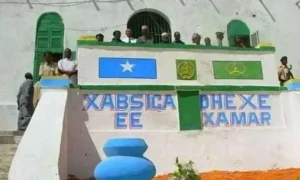Mogadishu, Somalia
According to experts, Somalia is experiencing its worst drought crisis in a decade, with millions of Somalis going hungry and being forced from their homes in search of food and water across other parts of Somalia. We have seen dozens of IDPs camps prop up across southern and central Somalia as more families flee the countryside.
Earlier this month, the United Nations humanitarian chief, Martin Griffiths warned that Somalia is on the brink of famine following the worst drought in four decades. During a news conference in Mogadishu, Griffiths said he had “concrete indications” that famine may occur in the southern Bay region by the end of the year.
Griffiths visited various regions and towns across Somalia including Baydhabo and the capital, Mogadishu. Overall, the United Nations and Somali government say 7.8 million people nationwide are in desperate need of humanitarian assistance as the drought drags on and the food situation gets worse. More than 850,000 people are in the currently affected areas, with tens of thousands more arriving in the months to come according to UN experts.
The reality is that climate change continuous to damage Somalia’s environment and increasing the number of famines in the country. A formal famine declaration is rare and a warning that too little help has come too late. At least 1 million people in Somalia have been displaced by the driest drought in decades, driven by climate change that also affects the wider Horn of Africa including Ethiopia and Kenya.
In June, UNHCR announced it needs US$9.5 million for Somalia, as part of its regional appeal for the Horn of Africa, to help displaced communities affected by the catastrophic drought.
Horufadhi Media organized an online discussion on the aforementioned subject in light of the severe and dire socio-environmental condition that Somalia is currently experiencing and what role the Somali youth both at home and abroad can do to support and raise awareness of climate change, an alien concept in Somalia up until now.
The main goal was to increase public awareness of the negative effects of climate change and the related socio-environmental issues, while emphasizing the role of youth in combating climate change with the crux of the event being exchange scientific and local knowledge and ideas in search of answers to these problems.
Participants included, but were not limited to, the state minister for the environment and climate change of Somalia H.E. Adan A Hassan, representatives from local NGOs (e.g., Somali Climate Youth Action), citizens, and Somali environmental professionals. The general topic of debate was environmental deterioration and related social effects brought on by both climate change and human activity. One of the initial queries raised at the meeting was whether these difficulties were entirely caused by natural events or whether human activity also played a role. Another concern was the extent and availability of national, regional, and local initiatives, plans, programs, or strategies that would proactively address these challenges.
An issue that comes into mind is the current charcoal crisis in Somalia. The UN Convention to Combat Desertification, known as UNCCD, said an estimated 8.2 million trees were cut down for charcoal in Somalia between 2011 and 2017, increasing land degradation, food insecurity and vulnerability to drought. This directly impacts the environment in the country, increasing desertification.
According to numerous environmentalists, Somalia is currently facing a crisis that poses a major humanitarian conundrum including, but not limited to, droughts, desertification, scarce water supplies, deforestation, charcoal commercialization, flood flushes, and starvation. In recent years, these tragedies have become both far more frequent and intense. The forum also covered other important topics, such as the negative effects of oil and gas exploration on human health and the environment.
Climate Change Discussion
Climate change has played a significant role in making droughts in the Horn of Africa more intense and rain less predictable. In fact, the Earth’s temperature has already risen by 1.1 degrees and unfortunately, Somalia is listed as one of the most vulnerable countries in the world to this change in climate. It is predicted that Somalia’s temperature will increased to 3 degrees by the end of this century.
The change in climate is due to emissions from developed countries, mainly western countries and China however rarely has this resulted in an increased sense of responsibility or support for countries grappling with the affects of industrialisation elsewhere in the globe.
The forum generally discusses the course of climate change and its effects on Somalia. Expert guests and Ministers highlighted on our panel that Somalia’s rural areas are most affected by climate change. Not only can droughts, desertification, water shortages, and food shortages directly affect the local people, but it also has a serious and detrimental effect on their way of life, which is dependent on livestock and subsistence farming.
Somalis are known for their nomadic lifestyle.
Many of these communities are now internally displaced as they migrated to nearby towns and cities which created other resource challenges.
What role can the Government Play?
On our panel, State minister for the environment and climate change of Somalia H.E. Adan A Hassan, outlined the role and vision of Somalia’s Ministry of Environment and Climate with regard to environmental protection in particular combating climate change in Somalia. As climate change is a global crisis the minister discussed COP27 and meetings he recently had with his African counterparts at Sharm Al-Skeikh. The minister also emphasized the significance of having targeted and nationally tailored strategies and policies to couple with local and scientific knowledge while considering the best & most cost effective available technology address environmental challenges while achieving sustainable development. The minister also expressed worry about the extreme pressures that maritime activities, such as oil and gas development, the dumping of hazardous waste into the ocean, and maritime transportation, are putting on the marine habitat.
Somalia is currently looking to explore its oil reserves at a time where the globe is seeking to move away from the hazardous chemicals that have damaged our atmosphere. Many developed countries are aiming for zero carbon emissions by 2030 which demonstrates the direction the globe is moving in.
For Somalia, recent policies by the Joint Ministerial Committee on the signing of contracts and the interest of major oil companies indicate the government could be signing deals in the coming years.
The government must take into consideration the determinantal effects oil and gas exploration and usage has on our environment at a time where Somalia is in an uphill battle against climate change.
Lastly, the government can introduce new national programs to increase green space, tree planting and encourage farming to make Somalia more self-sufficient and tackle climate change better.
What about the Role of Youth
The involvement of local youth-focused NGOs like the Somali Climate Youth Action set this years climate change summit apart from others. Nations all over the world agreed that youth will be better able to combat climate change because of their capacity to implement reforms required to mitigate its effects. Several young people spoke about their experiences at the gathering. However, it is acknowledged that one of the biggest barriers keeping Somali youth from reaching their full potential was a lack of financial support. Despite this, the majority of Somali youth work voluntarily which demonstrates commitment.
The government can provide loans and programs via international support to financially support and incentives youths to partake in the fight against climate change.
Somali business tycoons and corporations must also provide private sector support to young Somalis and others that are working to tackle some of the issues faced by citizens including food shortages among other things.
Somalia & Oil and Gas Exploration
The role that oil and gas production could play in the nation’s economic development is a well-known truth. However, it is widely known that oil and gas fields and enterprises are sources of a wide range of poisonous and dangerous by-products that may unintentionally, on purpose, or negligently infiltrate the environment. It is well recognized that certain discharges of gases, including sulfuric compounds, have negative effects on both the environment and human health. Hazardous solid wastes can comprise a variety of toxic substances, such as organic and inorganic waste, naturally occurring radioactive material (NORM), whereas liquid waste is typically made up of various heavy metals and organometallics. This can result in Minamata disease contaminating drinking water (both surface and groundwater) as well as seawater.
Minamata disease is a methylmercury poisoning with neurological symptoms and caused by the daily consump- tion of large quantities of fish and shellfish that were heavily contaminated with the toxic chemical generated in chemical factories and then discharged into the sea.
It is also well recognized that the oil and gas sectors are directly and indirectly to blame for habitat loss and ecosystem degradation. Therefore, to separate the risks from the rewards, environmental and social considerations should be placed on an equal footing with the economic considerations. Accordingly, a project-specific SEA and EIA are required prior to the project’s various phases, including the geophysical survey, drilling, construction, commissioning, operation, transportation, and other associated activities. Furthermore, it is well known that consequences will differ from project to project due to a variety of factors, such as the sensitivity of the environment (for example, whether it is offshore or onshore), technology, and the seasons.
Recommendations
- The participant acknowledged the benefits of organizing a meeting like this one to promote awareness of climate change. In response, the participant thanked Horufadhi Media and requested them to organize other meetings and discussions on the subject.
- Since this is Somalia’s first environment and climate change ministry, the panel unanimously concluded that new regulations and initiatives are needed to combat environmental challenges.
- The meeting underlined the need for reliable data reflecting the nation’s environment in order to develop the necessary policies, plans, and programs to avert climate change. Moreover, Somalia needs to establish specialized research and development institutes such as
- Environmental research,
- Energy research,
- Food, livestock, and fishery research
- water research and so on
- The panel agreed that there has to be a major increase in educational initiatives aimed at changing people’s attitudes around environmental activities (such as deforestation) and climate change.
- The meeting acknowledged the tragedy of flood flush and the need to capture water using practical and affordable country-tailored water management, including but not limited to water policy, the creation of wetlands, the establishment of emergency flood areas (at the source), the construction of strategic dams, and the use of geological reservoirs as storage facilities among other methods.
- The forum recognized the need for creating a national drought plan (NDP) and urged reforestation initiatives in relation to droughts and desertification. The meeting also issued a caution against using invasive plants from neighbouring nations. The meeting promoted the usage of local and indigenous species so far as reasonably practicable.
- Participants in the discussion agreed that proactive planning and environmental impact assessments should be done before beginning any oil and gas exploration activities.
Written by: Suldan Mohamed and Suleiman Hashi







